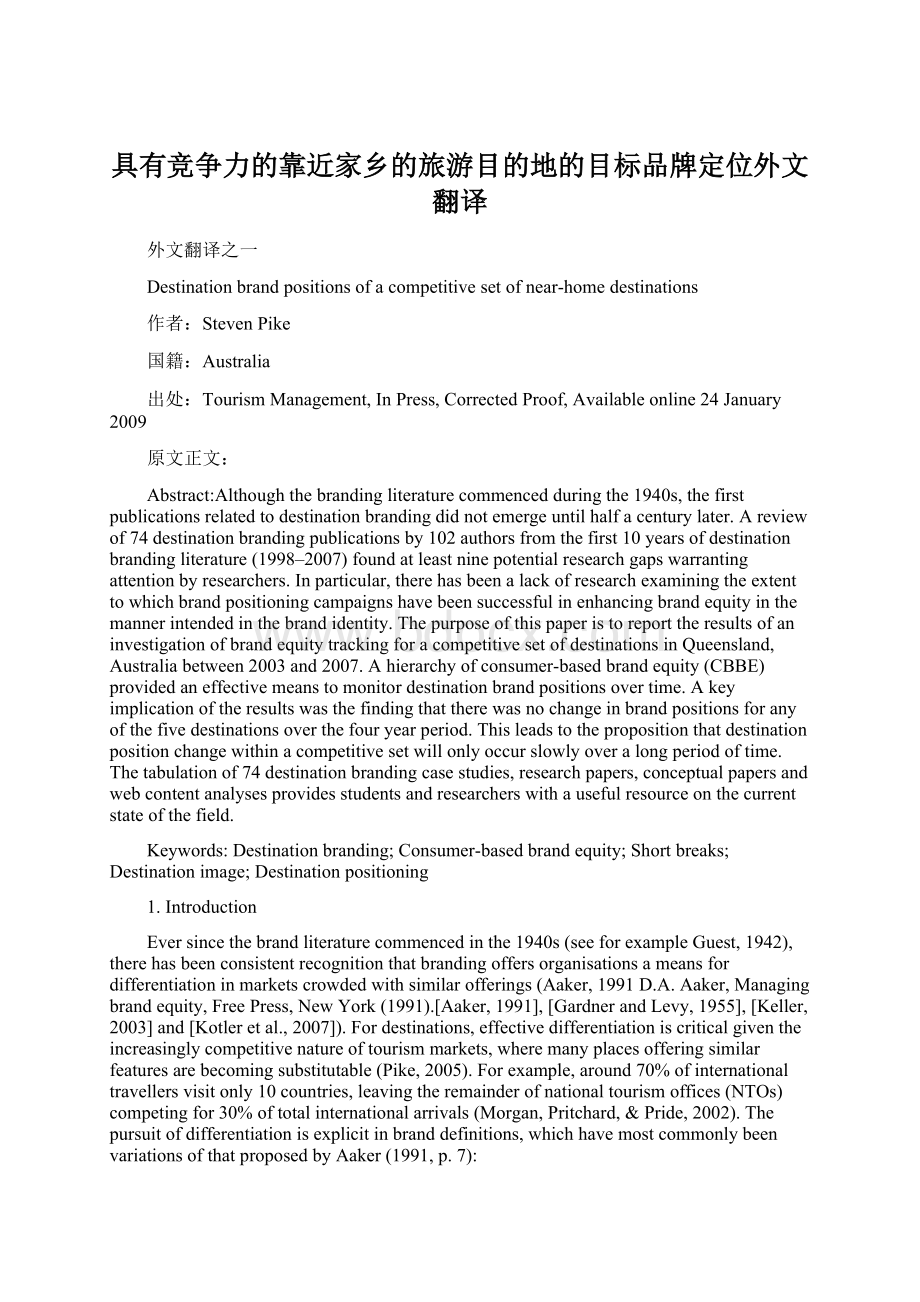具有竞争力的靠近家乡的旅游目的地的目标品牌定位外文翻译Word下载.docx
《具有竞争力的靠近家乡的旅游目的地的目标品牌定位外文翻译Word下载.docx》由会员分享,可在线阅读,更多相关《具有竞争力的靠近家乡的旅游目的地的目标品牌定位外文翻译Word下载.docx(8页珍藏版)》请在冰豆网上搜索。

Althoughthebrandingliteraturecommencedduringthe1940s,thefirstpublicationsrelatedtodestinationbrandingdidnotemergeuntilhalfacenturylater.Areviewof74destinationbrandingpublicationsby102authorsfromthefirst10yearsofdestinationbrandingliterature(1998–2007)foundatleastninepotentialresearchgapswarrantingattentionbyresearchers.Inparticular,therehasbeenalackofresearchexaminingtheextenttowhichbrandpositioningcampaignshavebeensuccessfulinenhancingbrandequityinthemannerintendedinthebrandidentity.ThepurposeofthispaperistoreporttheresultsofaninvestigationofbrandequitytrackingforacompetitivesetofdestinationsinQueensland,Australiabetween2003and2007.Ahierarchyofconsumer-basedbrandequity(CBBE)providedaneffectivemeanstomonitordestinationbrandpositionsovertime.Akeyimplicationoftheresultswasthefindingthattherewasnochangeinbrandpositionsforanyofthefivedestinationsoverthefouryearperiod.Thisleadstothepropositionthatdestinationpositionchangewithinacompetitivesetwillonlyoccurslowlyoveralongperiodoftime.Thetabulationof74destinationbrandingcasestudies,researchpapers,conceptualpapersandwebcontentanalysesprovidesstudentsandresearcherswithausefulresourceonthecurrentstateofthefield.
Keywords:
Destinationbranding;
Consumer-basedbrandequity;
Shortbreaks;
Destinationimage;
Destinationpositioning
1.Introduction
Eversincethebrandliteraturecommencedinthe1940s(seeforexampleGuest,1942),therehasbeenconsistentrecognitionthatbrandingoffersorganisationsameansfordifferentiationinmarketscrowdedwithsimilarofferings(Aaker,1991D.A.Aaker,Managingbrandequity,FreePress,NewYork(1991).[Aaker,1991],[GardnerandLevy,1955],[Keller,2003]and[Kotleret
al.,2007]).Fordestinations,effectivedifferentiationiscriticalgiventheincreasinglycompetitivenatureoftourismmarkets,wheremanyplacesofferingsimilarfeaturesarebecomingsubstitutable(Pike,2005).Forexample,around70%ofinternationaltravellersvisitonly10countries,leavingtheremainderofnationaltourismoffices(NTOs)competingfor30%oftotalinternationalarrivals(Morgan,Pritchard,&
Pride,2002).Thepursuitofdifferentiationisexplicitinbranddefinitions,whichhavemostcommonlybeenvariationsofthatproposedbyAaker(1991,p.7):
Abrandisadistinguishingnameand/orsymbol(suchasalogo,trademark,orpackagedesign)intendedtoidentifythegoodsorservicesofeitheroneselleroragroupofsellers,andtodifferentiatethosegoodsfromthoseofcompetitors.
However,intheforewordtothefirstissueofPlaceBrandingandPublicPolicy,editorSimonAnholt(2004,p.4)suggested“almostnobodyagreesonwhat,exactly,brandingmeans”indescribingplacebrandingpracticeasakintotheWildWest.Therehasbeenalackofconsistencyindefiningwhatconstitutesdestinationbranding,bothwithinindustryandwithinacademia(see[Blainet
al.,2005],[ParkandPetrick,2006]and[TasciandKozak,2006]).ThemostcomprehensivedefinitiontodatehasbeenthatproposedbyBlainet
al.(2005,p.337),whichfollowedBerthon,Hulbert,andPitt'
s(1999)modelofthefunctionsofabrandfromboththebuyerandsellerperspectives:
Destinationbrandingisthesetofmarketingactivitiesthat
(1)supportthecreationofaname,symbol,logo,wordmarkorothergraphicthatreadilyidentifiesanddifferentiatesadestination;
that
(2)consistentlyconveytheexpectationofamemorabletravelexperiencethatisuniquelyassociatedwiththedestination;
that(3)servetoconsolidateandreinforcetheemotionalconnectionbetweenthevisitorandthedestination;
andthat(4)reduceconsumersearchcostsandperceivedrisk.Collectively,theseactivitiesservetocreateadestinationimagethatpositivelyinfluencesconsumerdestinationchoice.
Brandingisthereforeconsideredmutuallybeneficialfromboththesupplyanddemandperspectives.Enhancingtheabilityofthebrandtodifferentiateeffectivelycangenerateadvantagesforproductsandservices,suchasincreasedpurchaseintent(Cobb-Walgren,Beal,&
Donthu,1995),lowercosts(Keller,1993),increasedsales,pricepremiums,andcustomerloyalty([Aaker,1991]and[Aaker,1996]).Advantagesfordestinationmarketingorganisations(DMO)includeincreasedpotentialtodifferentiateagainstplacesofferingsimilarbenefits,increaseddestinationloyaltyandincreasedyieldforstakeholderssuchaslocaltourismbusinessesandtravelintermediaries.Benefitsforthetravellerincludeeaseofdecisionmakingthroughreducedsearchcosts,reducedrisk,andpossiblyenhancedbragvalue.
Thefocusofmostresearchreportedtodatehasbeenconcernedwiththedevelopmentofdestinationbrandidentitiesandtheimplementationofcampaigns(seeforexample,[CrockettandWood,1999],[Hall,1999],[May,2001]and[Morganet
al.,2002]).Onearearequiringincreasedattentionisthatoftrackingtheperformanceofdestinationbrandpositionsovertime.Thatis,theextenttowhichdestinationbrands'
positioningandrepositioningcampaignshavebeeneffectiveinenhancingbrandequityconsistentwiththatintendedinthebrandidentity.Thisisanimportantgapinthetourismliterature,given:
i)increasingcompetition(seeMorgan,Pritchard,&
Piggot,2002),ii)theincreasinglevelofinvestmentbydestinationmarketingorganisations(DMO)inbrandingsincethe1990s,iii)thecomplexpoliticalnatureofDMObranddecisionmakingandincreasingaccountabilitytostakeholders(seePike,2005),andiv)thelong-termnatureofrepositioningadestination'
simageinthemarketplace(seeGartner&
Hunt,1987).IntermsofmetricsforDMOsingeneral,anumberofresearchersinvariouspartsoftheworldhavepointedtoalackofmarketresearchmonitoringeffectivenessofdestinationmarketingobjectives,suchasinAustralia(see[Carsonet
al.,2003]and[Prosseret
al.,2000]),NorthAmerica([Masberg,1999]and[SheehanandRitchie,1997]),andEurope(Dolnicar&
Schoesser,2003).
Theaimofthisstudywastotrackthebrandpositionsheldbyacompetitivesetofnear-homedestinationsbetween2003and2007.Forthispurposetheefficacyofahierarchyofconsumer-basedbrandequity(CBBE)wastrialled.CBBEwasfirstpromotedby(Aaker,1991)and(Aaker,1996)andmorerecentlyby(Keller,1993)and(Keller,2003)tosupplementtraditionalbalancesheetbrandequitymeasures.TherationaleunderpinningCBBEasabrandperformancemetricisthatconsumerperceptionsofthebrandunderpinanyfinancialestimateoffutureearningsestimatedinthefinancialmeasureofbrandequity.Sinceafinancialbalancesheetbrandequitymeasurewillbeoflittlepracticalvaluetodestinationmarketers,theconceptofCBBEisworthyofconsiderationbyDMOs.However,thepotentialof
CBBEfordestinationshasonlyrecentlyattractedtheattentionofacademicresearchers(see[Booet
al.,inpress]and[KonecknikandGartner,2007]).
具有竞争力的靠近家乡的旅游目的地的目标品牌定位
史蒂文・派克
澳大利亚
旅游管理,新闻,更正的证明,可在线2009年1月24日
中文译文:
摘要:
虽然品牌学在20世纪40年代就已经兴起,第一个与目的地品牌相关的出版物却直到半个世纪后才出现。
对102个作者关于74个目的地品牌出版物的回顾发现(1998-2007),至少有9个研究方面存在不足和缺陷,值得引起研究人员的重视。
尤其是,缺乏对检验品牌定位在何种程度上提高了品牌标识价值的研究。
本文的目的是报告澳大利亚昆士兰州2003年至2007年跟踪调查的品牌资产调查结果。
基于消费的品牌资产分级研究提供了有效的监测目的地品牌随着时间推移的变化。
调查结果中的一个关键意义发现过去4年的时间里5个目的地品牌没有发生任何的变化。
这个结果证明在竞争市场中目的地地位变化只会在一个很长的时间里慢慢变化。
表格中的74目的地品牌的案例研究,研究论文,概念文件和网页内容的分析,为学生和研究人员在当前领域内提供了有效的资源。
关键词:
目的地品牌;
消费者的品牌资产;
短休息;
目的地形象;
目标定位
1.导言
自从品牌学开始于1940年(参照盖斯特,1942),人们一致认识到品牌化提供给充满同质化产品的组织企业们以不同的手段去区分其产品([艾克,1991],[加德纳和利维,1955],[凯勒,2003]和[科特勒等人,2007])。
对于目的地来说,旅游供应市场的竞争正在变得越来越激烈,产品类似度惊人,而行之有效的市场区分使产品变得可替代。
(派克,2005年)例如,约70%的国际旅游者仅仅访问10个国家,使剩余的国家旅游办事处(NTOS)争夺30%的国际游客总数。
(摩根,普里查德,与自豪,2002年)追求分化是品牌明确的定义,这里最常见的变化是艾克提出的(1991,第7页):
一个品牌是一个区分的名称和/或符号(如标志、商标或包装设计)旨在确定的商品或服务的任何一个卖方或一群卖主,并从这些竞争对手中区分这些物品。
然而,在前言的第一个问题的地方品牌和公共政策,编辑西蒙安霍尔特(2004年,第4页)建议“几乎没有人同意,究竟是什么造成品牌的意思是”在描述的地方品牌做法类似于狂野的西部。
一直缺乏连贯性,确定什么构成目的地的品牌,不仅在行业内和学术界(见[布莱恩等人。
2005],[帕克和派崔克,2006]和[塔什哲和科扎克,2006])。
迄今为止最全面的定义是由布莱恩等人提出。
(2005年,第337页),而贝松、赫伯特和皮特(1999)品牌功能的模型从买方和卖方的观点是这样表述的:
目的地品牌的一系列营销活动包括:
(1)支持建立一个名称,符号,标志,文字标记或其他图形,便于识别和区分的目的地;
(2)不停传达一种和目的地相关的难忘的旅游经历的期望;
(3)有利于巩固和加强游客和目的地之间的情感联系;
(4)减少消费者的搜寻成本和感知风险。
总的来说,这些活动有助于建立一个目的地形象,积极的影响消费目的地的选择。
品牌话因此被认为可以为供求双方同时带来好处。
提高品牌的区分度可以有效的形成产品的优势,例如,如增加购买意向(柯布瓦尔格伦,比尔和敦修,1995年),降低成本(凯勒,1993年),增加销售,价格优惠,提高客户忠诚度([艾克,1991]和[艾克,1996])。
旅游目的地营销机构的优势(DMO)包括增加分化对地方提供类似的福利的潜力,增加目的地的忠诚度和增加利益相关者的产量,如当地旅游企业和旅游中介机构。
其优势包括便于决策通过降低搜寻成本,减少风险,并有可能增强炫耀的价值。
大多数研究报告的重点与目的地品牌特征和应用相关见例如,[克罗克特和伍德,1999],[豪尔,1999],[2001年05月]和[摩根等。
2002])。
一个需要越来越多注重的区域是跟踪记录品牌随着时间推移的提高程度。
也就是说,品牌标识在何种程度上目的地品牌的定位和重新定位的广告系列已有效地提高品牌资产相一致。
这在旅游学里是一个重要的差别,原因是:
1.日益激烈的竞争(见摩根普里查德和皮哥特,2002年)2.旅游目的地营销机构(DMO)从上世纪90年代以来越来越高的投资水平3.复杂的政治性质,DMO的品牌决策和加强问责制,以利益相关者(见派克,2005年)4.长期性的重新定位的目的地的形象在市场上(见加特纳与亨特,1987年)。
一般情况下,一些研究人员在世界各地都指出,目的地营销目标缺乏市场调研监测效力,如在澳大利亚(见[卡森等人。
2003]和[普罗塞尔等。
2000]),北美洲([马斯博格,1999年]和[希恩和里奇,1997])和欧洲(多尼卡&斯赛瑟,2003年)。
本研究的目的是跟踪2003年至2007年之间近距离目的地品牌定位问题。
为达到这一目的,要运用到以效能等级分级的消费为基础的品牌资产(CBBE)测试。
CBBE首先倡导的(艾克,1991年)和(艾克,1996年)和最近的(凯勒,1993年)和(凯勒,2003年),以补充传统的资产负债表的品牌资产的措施。
以目的地市场营销的概念,CBBE是值得考虑的目的地管理组织。
然而,潜在的CBBE目的地最近才引起注意的学术研究(见布等人。
在新闻发布会上]和[高耐尼克和加特纳,2007])。
外文翻译之二
Theattractivenessandcompetitivenessoftouristdestinations:
AstudyofSouthernItalianregions
MariaFrancescaCracoliciandPeterNijkamp
Italy
TourismManagement,Volume30,Issue3,June2009,Pages336-344
Thepresentpaperaimstoassesstherelativeattractivenessofcompetingtourist